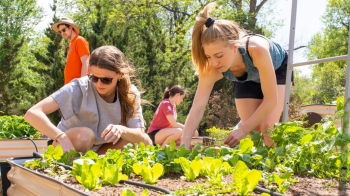Chase Barnett, OU-TU School of Community Medicine student, and co-creator of the Growing Health Garden, along with graduate Andrew Baker, shares how his inspiration came initially from his grandparents who always had a garden on their farm. This experience led him to realize how what we eat affects our overall health.
“I wanted to encourage patients, faculty, staff, and students to eat more fruits and vegetables and there’s no better way than simply having exposure to it and allowing people to sample from the garden and use the samples at home for free,” says Barnett. “Throughout my first couple years of medical school, lifestyle medicine expanded my knowledge of nutrition and the importance of it as well as how to counsel my future patients about it.”
So, during the difficult days of the COVID pandemic in 2020, Barnett and Baker got an idea to bring some wellbeing back to campus.
“I had the idea to create a garden as a form of wellness, both nutritional and therapeutic,” said Barnett. The two medical students worked together to develop the idea, fundraise for necessary supplies, and develop a formal plan for presentation to campus leadership with guidance from Marianna Wetherill, Ph.D., MPH, RDN/LD, associate professor at the Hudson College of Public Health and OU-TU School of Community Medicine and director of the Root Cause Food Equity Lab at OU-Tulsa. And in the summer of 2021 the garden idea put down roots in reality. It is located on the Tulsa Schusterman campus near the Schusterman Clinic where the entire campus community and visitors have access.
“The garden was designed to provide OU-Tulsa students with exposure to teaching gardens, leadership opportunities for maintaining them, and a tangible extension of lifestyle medicine outside the classroom for the benefit of OU-Tulsa students, OU Physicians staff, and OU Physicians patients,” says Dr. Wetherill.
Dr. Wetherill describes how students, faculty, staff and patients alike benefit from the presence of the garden. Students who spend time working there find it a way to relax between classes. The garden also produces enough for tasting, sharing, and use in the classroom, she says.




